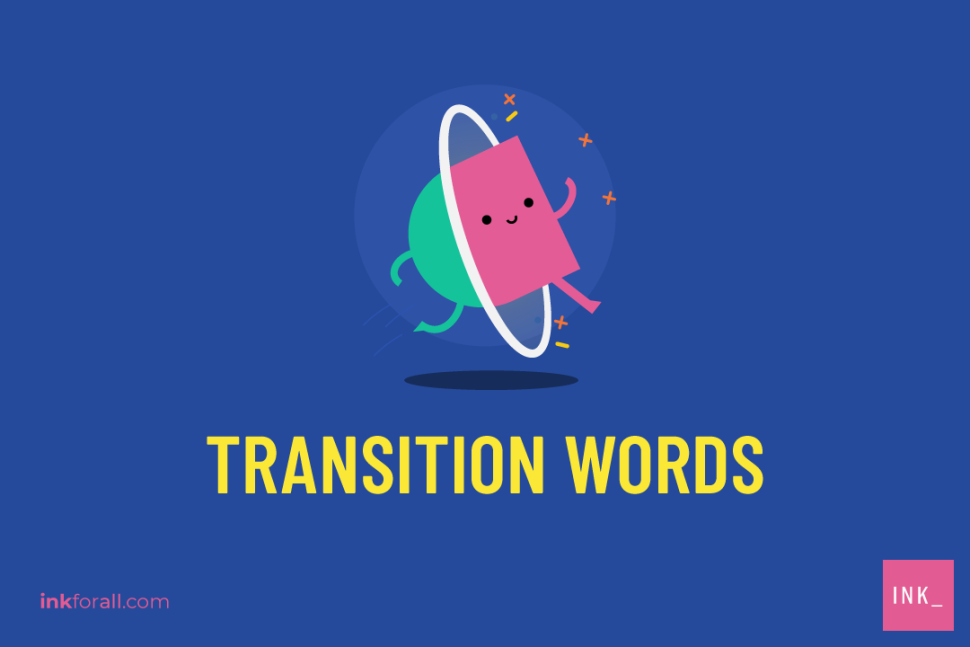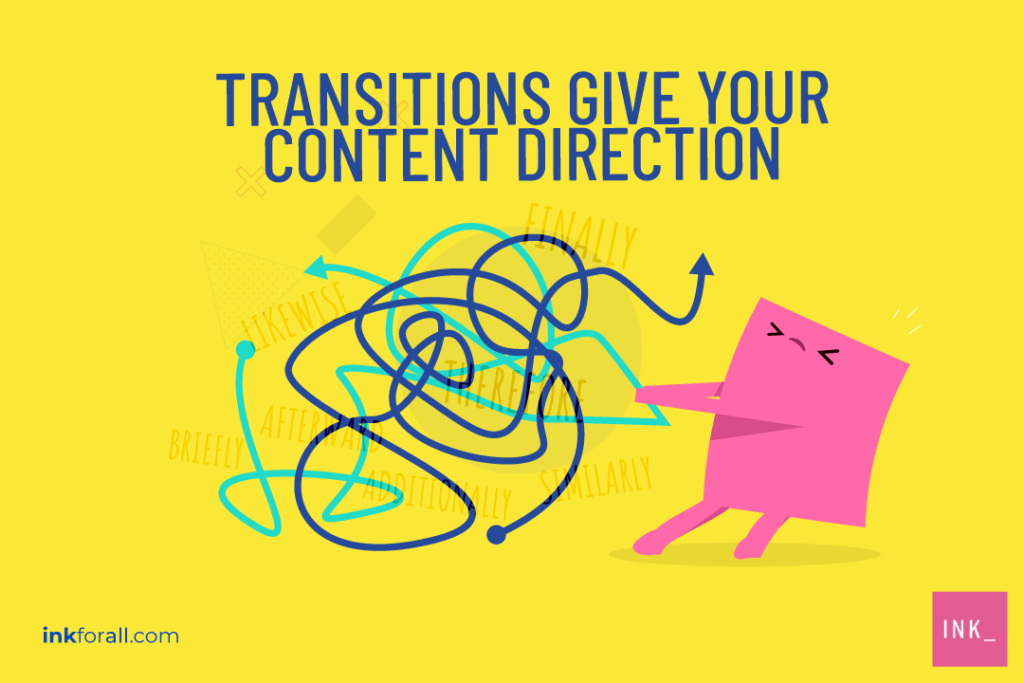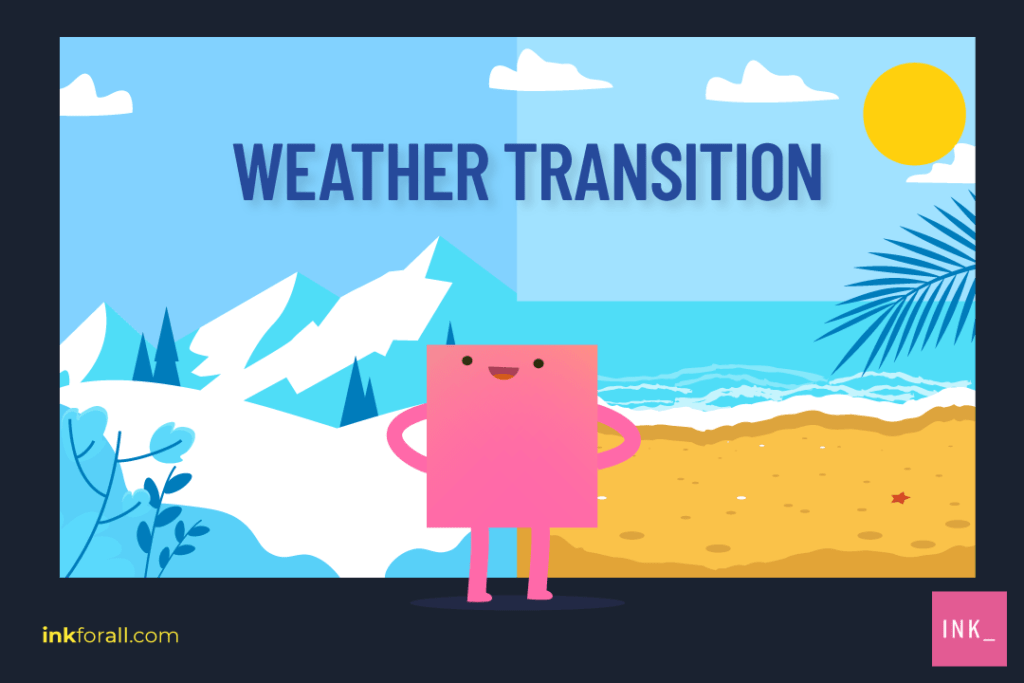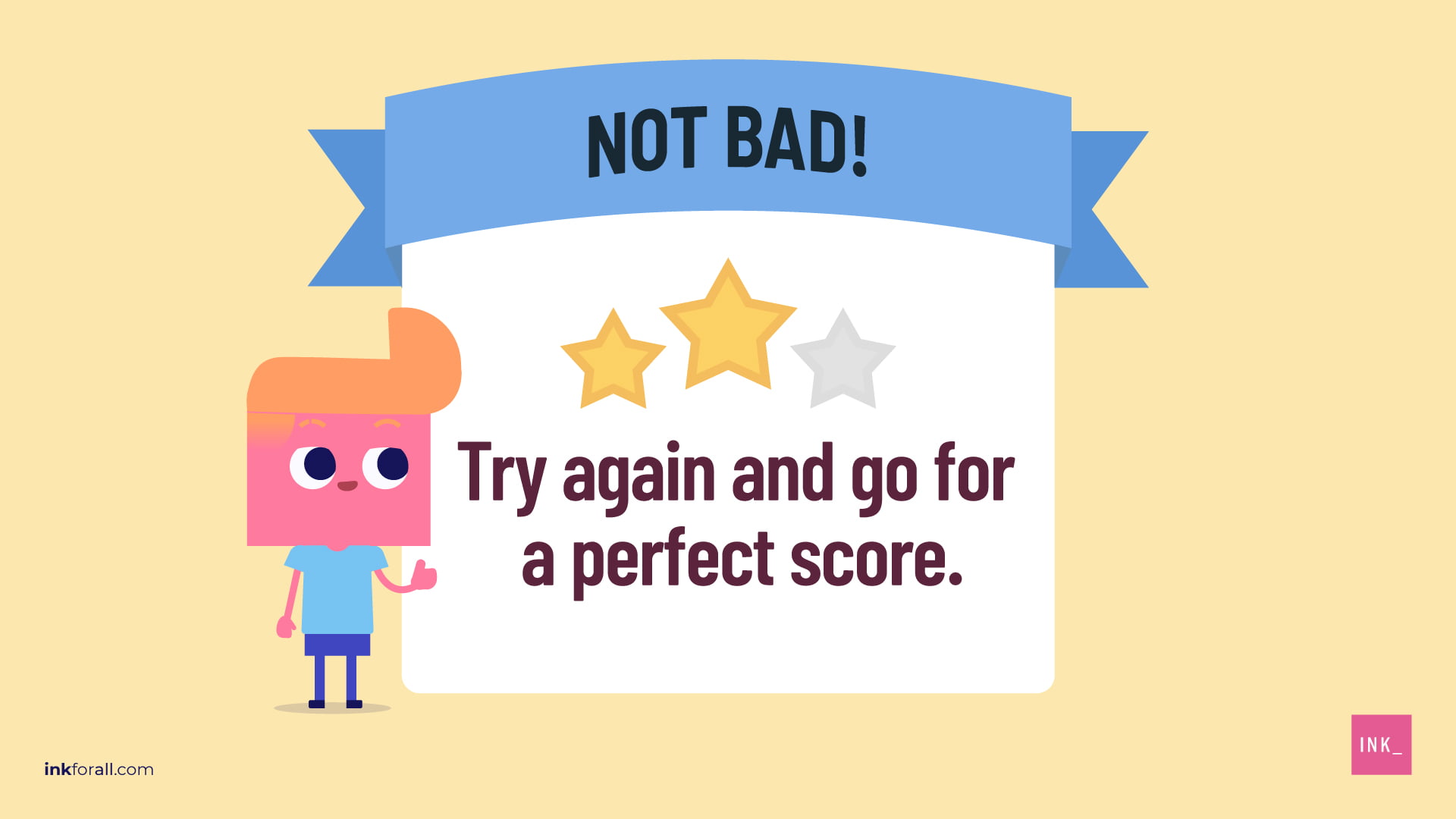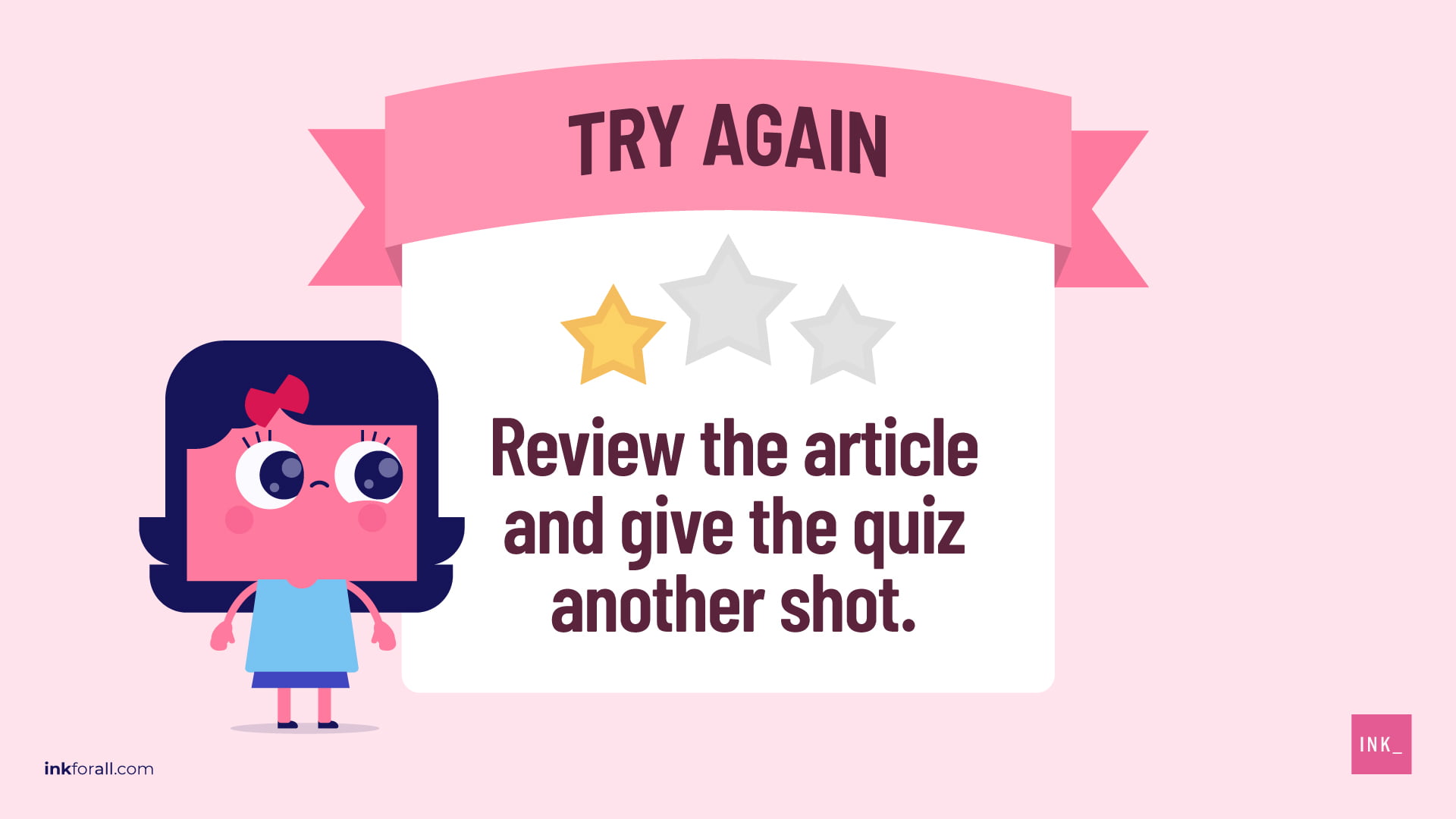Main Transition Words Takeaways:
- Transitional words are important because they help improve the flow between words, phrases, sentences, and paragraphs.
- They are important for SEO because they help make text easier to read and understand. Search engines and readers love content that is readable.
- Transition words help link ideas and statements.
- Using transitional words at the beginning or end of a paragraph can help the reader understand when you introduce a new topic.
- The four types of transition words are additive, adversative, causal, and sequential.
- Transition words and phrases don’t affect the grammatical structure of sentences and paragraphs.
What Are Transition Words?
As a writer, your primary goal is to present information and ideas to your target audience in a clear and understandable manner. The best way to do that is to use transition words. Transition words or transitional words are terms and phrases that help connect words, phrases, and even sentences together. They build connections between ideas in your content.
Transition words and phrases ensure that your written work will not look choppy and disjointed. They help your audience progress from one idea to the next. Think of them as a way to tell your readers how they should process and understand the information you are giving them. Transition words function like GPS, guiding your readers where they are going and how to get there.
What Are Some Examples Of Transition Words and Phrases?
Here are some of the most common examples of transition words and phrases:
Not to mention
Equally important
As a matter of fact
Not only/But Also
In addition
In fact
For example
What is more
In particular
On the other hand
When in fact
But even so
Whatever happens
In any case
Because of
Due to
In the event that
With this in mind
To conclude
By the way
To return to the subject
As has been mentioned
Given these points
Transition words are categorized based on their purpose. For instance, transition phrases like as a result of, due to, and as long as are used to emphasize cause and effect. Below are more examples of transition expressions that have been categorized based on their functions:
Cause and Effect
granted that
as long as
for the purpose of
in order to
in view of
as a result of
due to
because
therefore
consequently
so
accordingly
thus
hence
Since
for
owing to
as a consequence of
leads to
contributes of
stems from
comes from
results from
Evidence
as well as
and
too
also
in addition to
or
not only… but also
further
furthermore
besides
in addition
moreover
then
again
finally
by the same token
identically
uniquely
certainly
truly
including
to be sure
namely
chiefly
Contrast
however
on the other hand
otherwise
but
unlike
conversely
in spite of
at the same time
nevertheless
alternatively
on the contrary
yet
whereas
apart from
even so
although
while
Comparison
as
as if
similarly
equally
like
in the same way
comparable
as with
of contrast
despite this
in comparison
in contrast
even though
likewise
in like manner
Opinion
I feel
I believe
in my opinion
as fast as I know
in my experience
as for me, I think
if I’m not mistaken
I think
in my view
it seems likely
it seems to me
what I mean is
i’d say that
Similarity
moreover
as well as
together
of course
likewise
comparatively
correspondingly
similarly
furthermore
additionally
Clarification
that is to say
in other words
to clarify
that is
to explain
to put it another way
to rephrase it
in this case
I mean
up to a point
under certain circumstance
Sequence/ Order
first
second
next
finally
at this time
following
previously
before
prior to
before
Time
later
after
before
soon
meanwhile
during
subsequently
after that
at the present time
sooner or later
in due time
as long as
in the meantime
in a moment
at this instant
from time to time
Condition / Purpose
provided that
given that
in case
even if
only if
so as to
in as much as
when
whenever
if… then
unless
because of
as
while
lest
since
Emphasis
also
especially
furthermore
indeed
in addition
in particular
certainly
of course
significantly
notably
in fact
actually
in reality
as it happens
Conclusion
in conclusion
to conclude
finally
summarizing
overall
on the whole
to sum up
evidently
briefly
in short
altogether
in summary
to summarize
Place
here
there
over there
under
beyond
to the left
opposite
in the distance
Illustration
such as
in this case
for one thing
for example
in the case of
illustrated by
as an example
for instance
in other words
as revealed by
an instance
to show that
Reservation
admittedly
even so
as a matter of fact
indeed
nevertheless
even though
despite this
notwithstanding
regardless
What Are Some Examples of Transition Sentences?
The best way to understand how transitional words work is to see them in action. Remember, as important as these grammatical tools are, it’s not a good idea to overuse them. Too many transitional phrases can make your text seem complicated and wordy. It could also make you seem like a chronic overexplainer, and nobody wins when that happens.
You can use transitions to go from sentence to sentence:
You can also use transition words and phrases to go from paragraph to paragraph:
What Are the Four Types of Transition Words?
There are a lot of different ways to categorize transition words. In this post, we will discuss the four main types of transition words: Additive, Adversative, Causal, and Sequential.
1. What are Additive Transitions?
These transition words add or introduce another idea. They may also reference a previously mentioned concept, identify a similarity, or clarify an idea. Additive transitional words include:
2. What are Adversative Transitions?
Adversative transitions may be used to signal opposing ideas or dismiss a previously discussed idea altogether. Some adversative transition words include:
3. What are Causal Transitions?
As for causal transitions, they’re most commonly used to denote cause and effect. They may also indicate the reason an idea or action is happening or has happened. Causal transition words include:
4. What are Sequential Transitions?
As the name suggests, sequential transitions are used to put a sequence of ideas in order (usually chronological). This helps the reader understand where ideas fall in a list or when you’re wrapping up your text. Sequential transitions include:
Are Conjunctions Considered Transition Words?
While conjunctions and transitions share the same purpose — to connect ideas between or within sentences — they are not used the same way. You must not confuse conjunctions with transitional words or expressions. Conjunctions connect phrases and clauses, whereas transitions indicate the relationship between sentences and paragraphs. Check the following examples:
Subordinating conjunctions connecting dependent clauses with independent clauses:
Read More: The Easiest Way To Get Subordinating Conjunctions
Coordinating conjunctions connecting two independent clauses:
Transition words connecting sentences and paragraphs:
Another significant difference between transitions and conjunctions is their grammatical functions. Since conjunctions join clauses, they become part of the sentence and affect it grammatically. On the other hand, transition words have no impact on the grammatical structure of a sentence or paragraph. In short, you can remove a transition word, and it won’t have any impact on the sentence at all. Check the examples below:
Do Commas Go Before Or After Transition Words?
The placement of commas when using transition words will depend on where the latter appears in your text.
If your transition phrase appears at the beginning of the sentence, it is always set off with a comma.
If the transition word or phrase appears within an independent clause, it should be preceded by and set off with a comma.
If the transitional word appears between two independent clauses in a compound sentence, it should be preceded by a semicolon and set off with a comma.
How Are Transition Words Used in SEO?
SEO, or search engine optimization, is a process that involves optimizing your content for search engines to help improve ranking. The higher you are in search results, the more visibility your content will have. The more visible your content, the more people will see and learn about your brand.
Unlike keywords or meta tags, transitions between sentences or paragraphs don’t directly help boost your search ranking. Instead, it’s all about readability and structure.
See, Google runs on algorithms and those algorithms are big fans of order and ease of use. In other words, clarity is everything.
In the olden days (you know, like the 2010s), Google was like a heat-seeking missile for keywords. Basically, the more keywords you could stuff in your copy, the better you’d rank. That led to a lot of web pages that said something like, “buckets buckets buy some buckets buckets for sale the best buckets.”
What are they selling? You guessed it: buckets!
Google (and the rest of the world) soon realized the keyword stuffing wasn’t really good for anyone. Instead, search engines began focusing on how web pages could best serve the reader. Now, algorithms analyze web content for readability, and transition words play a huge role in that determination.
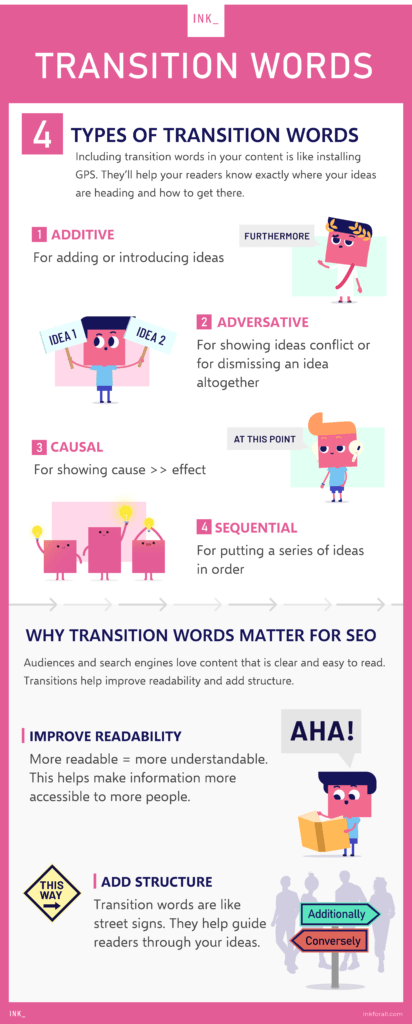
Transition Words Give Direction
Transition words also help you structure your content. Remember our road map? Transitional words can act as street signs, pointing readers left or right, directing them to take a U-turn, or propelling them onward.
Bottom line: Transition words make your content easier to read and understand. For this reason, it’s vital to rely not only on helpful tools but also on your own mind. If it reads well to you, it’ll likely read well to your audience.
Transition To a Closing
Finally, you can use transitions to introduce a new section or conclude your previous one—or wrap up the entire text. You may even use a transition to reinforce the general idea of your content before ending your piece:
Quick Transition Words Grammar Quiz
Transition Words Question #1
A. Causal
B. Additive
C. Adversative
D. Sequential
Correct!
Wrong!
The correct answer is letter C. Adversative transition words may be used to signal opposing ideas or dismiss a previously discussed idea altogether.
(E.g., but, however, conversely, still, and besides)
Causal Transition Question #2
A. Additionally
B. Consequently
C. Either way
D. To illustrate
Correct!
Wrong!
The correct answer is letter B. Consequently along with words like for, since, unless, as a result, and hence are all causal transition words.
(E.g., «Flexible workers often find themselves in great demand, and consequently, earn high wages.»)
Transition Words in SEO Question #3
A. They make content more interesting.
B. They make content easier to read.
C. They help increase word count.
D. Trick question! They’re not important for SEO at all.
Correct!
Wrong!
The correct answer is letter B. Transition words help improve the flow of ideas within a piece of content, making it more readable and easy to understand. Content with a high readability score can boost your SEO.
Transition Words Quiz Result
You’re an expert!
Not Bad!
Almost got it! Review the article and try again.
Read More: How to use a question mark (?)
Do you know the Brooklyn Bridge? Now, imagine the time before it was built—like before 1883.
Obviously I wasn’t there, but I can imagine that it was a struggle for someone to move across the East River between Brooklyn and Manhattan.
Well… you could still get across but not as conveniently as using the bridge—well, maybe they used boats or built small rafts. Not convenient, right?
Bottom line? They needed that bridge.
Likewise, if you want your writing to flow coherently and have the lucidity that makes it easily readable, you NEED transition words.
It’s that STRAIGHTFORWARD.
So what are these bridges? Transition words are words or phrases that connect sentences and paragraphs seamlessly and smoothen out any abrupt jumps or breaks between the sentences.
These words include ‘since to demonstrate’, ‘specifically’, ‘for instance’, ‘and’, ‘but’, ‘so’, and many others. These words are deliberately inserted into the text to show the relationship between phrases, sentences, or paragraphs. They are like soft-footed tour guides for your readers, helping them grasp your thoughts and where your ideas lead to.
On a basic level, we usually use conjunctions (“and,” “but” and “or”) as transition words, for example:
- They wanted to learn fast, and they completed the course with a quarter of the semester to spare.
- They wanted to learn fast, but they barely finished one module after the first month.
You can see that in the examples I gave above, the coordinating conjunctions were employed to indicate two different transitions.
- In the first case, “and” has been used to indicate a transition that connects two occurrences which were harmonized.
- The second sentence employed the conjunction “but” to introduce a contrast.
Just as illustrated in these examples, there are different categories of transition words that we use to get a point across.
Adverb as Transition Words
Apart from the conjunctions, adverbs are also transition words. Adverbs are words that describe the manner in which an action is performed or how two actions relate to each other.
These are examples of how we use them as transition words:
- He did quite an excellent job. Nonetheless, the client seemed a bit dissatisfied with the work.
- We don’t want another costly overseas trip; besides, we can’t afford it.
Can A Transition Be a Question?
Yes, but not necessarily.
Such a simple but somewhat confusing answer. It’s not a grammar rule but an observation that I have made.
As a rule of thumb (which I picked from a very good English tutor), I don’t put a comma after “but” when I use it instead of a conjunctive adverb (e.g., however, nevertheless).
So, if I start a sentence with a “but” and proceed with a question without “pausing”, it means that I have a transition that’s also a question.
For example:
Paragraph 1: The Corporation suddenly sold their stock in the rising company.
Paragraph 2: But how do you sell stock when the expectations are that the company is about to become more valuable?
Obviously my transition word, “but,” is not a question on its own, but the whole sentence is. Therefore, the sentence as a transition from paragraph “1” to “2” is a question.
But as I said, I’m yet to come across a general rule for this type of scenario.
What Are Some Examples of Transition Words?
There are just numerous examples of transition words. However, these words are used to perform different tasks—some are used to show turns and twists, others are employed to indicate similarity, etc.
Basically, we have categories of transition words (based on the type of transition the words represent when they launch a sentence).
These are categories:
Cause/Effect
- We lost. Therefore, we couldn’t proceed to the next round.
- He left Because he was worried about the health of his mother.
Others:
since, on account of, for that reason, consequently, accordingly, thus, hence, as a result.
Comparison/Contrast
- I’d have loved to go, but I have some urgent business here.
- On the contrary, they believed that he was a fool.
- Likewise, the driver of the white van left the boxes on his door.
Others:
Yet, and yet, nonetheless, at the same time, after all, In the same way, by the same token, in like manner, likewise, in similar, but, however, though, otherwise, on the contrary, in contrast, notwithstanding, nevertheless, similarly, on the other hand,
Examples
- Specifically, Jane likes blue shoes.
- To demonstrate its might, the empire wants to impose sanctions on its tiny neighbor.
Others:
for example, to illustrate, for instance, as an illustration, e.g. (for example).
Clarification
- In other words, he wants you to go.
- To put it another way, your company doesn’t need any more liabilities.
Others:
to clarify, to explain, that is to say, i.e. (that is), to rephrase it.
Qualification
- This is possibly the best score in ten years.
- With this in mind, the board declared him the best investment banker of that year.
Others:
Probably, always, nearly, never, maybe, frequently, perhaps, although.
Addition
- Moreover, I wanted to go hiking with her friends.
- Furthermore, the higher you go, the harder it becomes to climb down.
Others:
in addition, even more, too, also, last, lastly, finally, in the second place, again, next, further, besides, and, or, nor, first, second, secondly.
Summary/Conclusion
- Given these points, it is very apparent that she is knowledgeable about what is going on.
- In the long run, everyone will earn huge dividends from their investment.
Others:
In conclusion, to sum up, to summarize, in sum, in brief, in short, in summary, to conclude, finally.
Chronology/Time
- He wrote her a note Before left for Italy.
- During the event, you could hear them chant war cries.
- Later that evening, he arrived with a big entourage.
Others:
While, now, immediately, following, never, after, earlier, always, when, whenever, meanwhile, soon, sometimes, afterwards, until now, next, once, then, at length, simultaneously, so far, this time, subsequently, in the meantime.
Emphasis
You have to have a hard-working attitude and self-belief. Above all, you have to put all your trust in God.
Others:
Above all, most importantly, certainly.
When to Use a Transition Word
To Glue a Single Sentence
Transition words are used to link parts of the same sentence.
Here are some examples:
- The boss acts as if the employees are just little kids under his supervision.
- He prefers to go by himself rather than send someone else in his place.
- The company did not adopt his proposed marketing strategy, yet if they had savvy executives, they would have realized how innovative and profitable his plans were.
To Start a Paragraph
Before choosing a transition word or phrase, always think about the cohesiveness—between the current paragraph and the one that precedes it—the transition will bring. Are the two paragraphs carrying comparing and contrasting ideas? Are you trying to describe events in chronological order?
When we use transitions to introduce a new paragraph, they are usually phrases or clauses which refer to the preceding paragraph while launching a new idea.
The transitions that we often used at the beginning of new paragraphs may be phrases like these:
- It follows logically that entity A and B cannot be clearly distinguished by dead reckoning.
- Furthermore, the gentleman has confessed his crime and has named his accomplices.
- In conclusion, the theory does hold in reality.
- Lastly, an investigation needs to be launched to find out what really happened here.
Coherence is what your transitions are there to help you with. Therefore, you ought to place a great emphasis on the gluiness of your transitions.
Gluing Paragraphs
Inside your paragraph, transitions have to help you explain the relationships between your ideas. You have to think about what the previous sentence before this one says and how that sentence or phrase relates to the one the transition is trying to introduce.
Do you want to add more information to the preceding sentence? Or, do you want to emphasize the subject succeeding the transition?
When we use transitional words to stitch a paragraph, we often try to make it flow smoothly. In the next example, I have used transition words to stitch together a short paragraph.
A Paragraph Without Transitions: He left his job in Louisiana. His mother was ill. She recovered, he went back to Louisiana.
A Paragraph with Transitions: He left his job in Louisiana because his mother was ill. After she’d recovered, he went back to Louisiana. But, he no longer had a job and had to start from scratch again.
Do Transitions Help in Writing a Story?
Not only do transitions help in writing a story, but they also help you quickly and easily improve your writing. There are plenty of benefits of using transitions.
Firstly, using transitions is a good way of programming yourself to transcend the subaltern practice of using a basic subject-verb sentence structure. With transitions, you have sentences which are more complex but still coherent.
Besides adding to the complexity of your sentences, the stitching factor that transitions bring to your text makes it readable and helps you create passages with a bit more refinement.
Finally, perfectly employed transitions can make your writing sound more professional. Professional writers know that there should be a noticeable difference between written and spoken language (unless it’s dialogue). Transitions give your writing a tinge of that much-needed professionalism, just enough to make it sound better than spoken English.
Signs That You Need to Work On Your Transitions
There are a couple of red flags that pop up whilst writing or when you’re provided with feedback. Here are some of the scenarios that require you to work on your transitions:
- When you submit a manuscript or an academic assignment and you’re bombarded with comments like “this is choppy,” “it’s jumpy,” “the passages aren’t flowing smoothly,” “your writing desperately needs signposts,” or “how are paragraph X and Y related?”
- When you get feedback from your readers, saying they are having a tough time following the structure and flow of your content.
- When you take separate, disjointed chunks of texts and stitch them together without adding adhesive words or phrases.
- When you are working on a group assignment and the draft includes parts written individually by several group members.
How Can I Improve My Use of Transition Words
The fact that everyone uses transition words is quite apparent. But, using them correctly or efficiently isn’t something which every writer does naturally. Using transition words effectively is a result of a couple of things. To successfully use transitions, you have to:
1. Arrange Your Thoughts and Ideas
Remember what I said about transition words acting like bridges linking your paragraphs and sentences together? Well, they are more than that.
They’re also signposts. Before writing a blog post, news article, or a book, one usually has a bunch of incoherent but lucid ideas to work with. Usually, you—the writer—know where your story is going but you need to give the reader some directions.
They have to understand and follow your arguments and you have to clearly define the relationships between different sentences or parts of writing.
Your writing needs to have a firm structure and it’s the effective use of transition words that will help you give the text that structure.
But first, you need to know how your ideas relate to each other. It needs to be clear to you which idea introduces the other, which breaks away from the original points, and so on and so forth. This means that you have an introduction, body, and conclusion.
Afterwards, you can start adding meat to the skeleton, sew the sentences together. Find jumps and breaks that present perfect slots for transitions and make sure the transitions employed make sense.
2. Know the Transition Words
This is usually a problem for non-native speakers. But, many native speakers tend to “underutilize” transition words; they simply don’t pay attention to some less frequently used transitions.
So, whether you’re a native speaker or not, it’s prudent to look up a list of transition words and study their employment. It’s not only a matter of having used the transition word before, sometimes, their usage may depend on context like the “i.e.” vs “e.g.” case which is a grammatical evil that has preyed on a lot of unsuspecting native speakers.
Knowing the words helps you contextualize the transitions.
My Final Words On Transitions
Transition words are essential for the readability of your writing. Unfortunately, a lot of people fail to utilize them effectively. If you are one of these people, don’t worry about it too much. Study them and practice a lot.
Like a lot, A LOT. Always be aware of the way you structure your text. In this way, it will be less of a task trying to choose the best transitions to use.
From Wikipedia, the free encyclopedia
A transition or linking word is a word or phrase that shows the relationship between paragraphs or sections of a text or speech.[1] Transitions provide greater cohesion by making it more explicit or signaling how ideas relate to one another.[1] Transitions are, in fact, «bridges» that «carry a reader from section to section».[1] Transitions guide a reader/listener through steps of logic, increments of time, or through physical space. Transitions «connect words and ideas so that […] readers don’t have to do the mental work for [themselves].»[2]
Definition[edit]
In simple terms, a transition word demonstrates the relationship between two portions of a text or spoken language. By using the imagery of a bridge, a person can see how these words take readers/listeners from one statement to another. By using these words, people can better build a sentence and convey what they are trying to say in a more concise manner.[3]
Coordinating transitions[edit]
Elements in a coordinate relationship are equal in rank, quality, or significance.[4] They help to show a link between equal elements.[5]
- To show similarity or reinforce: also, and, as well as, by the same token, comparatively, correspondingly, coupled with, equally, equally important, furthermore, identically, in the light of, in the same fashion/way, likewise, moreover, not only … but also, not to mention, similarly, to say nothing of, together with, too, uniquely
- To introduce an opposing point: besides, but, however, in contrast, neither, nevertheless, nor, on the contrary, on the other hand, still, yet[5]
- To signal a restatement:[6] in other words, in simpler terms, indeed, that is, to put it differently
Subordinating transitions[edit]
- To introduce an item in a series:[7] finally, first, for another, for one thing, in addition, in the first place, in the second place, last, next, second, then[8]
- To introduce an example:[9] for example, for instance, in particular, namely, specifically, that is
- To show causality: accordingly, as a result, because, consequently, for, hence, since, so, then, therefore, thus
- To introduce a summary or conclusion:[7] actually, all in all, altogether, clearly, evidently, finally, in conclusion, of course, to sum up
- To signal a concession:[9] certainly, granted, it is true, naturally, of course, to be sure
- To resume main argument after a concession: all the same, even though, nevertheless, nonetheless, still
Temporal transitions[edit]
- To show frequency: again and again, day after day, every so often, frequently, hourly, now and then, occasionally, often
- To show duration: briefly, during, for a long time, minute by minute, while
- To show a particular time: at six o’clock, at that time, first thing in the morning, in 1999, in the beginning of August, in those days, last Sunday, next Christmas, now, then, two months ago, when
- To introduce a beginning: at first, before then, in the beginning, since
- To introduce a middle: as it was happening, at that moment, at the same time, in the meantime, meanwhile, next, simultaneously, then
- To signal an end (or beyond): afterward/afterwards, at last, eventually, finally, in the end, later
Spatial transitions[edit]
- To show closeness: adjacent to, alongside, close to, facing, near, next to, side by side
- To show long distance: away, beyond, far, in the distance, there
- To show direction: above, across, along, away from, behind, below, down, in front of, inside, outside, sideways, to the left, to the right, toward/towards, up
Transition words of agreement, addition, or similarity[edit]
The transition words, such as also, in addition, and likewise, add information, reinforce ideas, and express agreement with preceding material.[10]
- additionally
- again
- also
- and
- as
- as a matter of fact
- as well as
- by the same token
- comparatively
- correspondingly
- coupled with
- equally
- equally important
- first
- furthermore
- identically
- in addition
- in like manner
- in the first place
- in the light of
- in the same fashion/way
- like
- likewise
- moreover
- not only … but also
- not to mention
- of course
- second
- similarly
- then
- third
- to
- to say nothing of
- together with
- too
- uniquely
- what’s more
See also[edit]
- Conjunction
- Level of measurement
- Concept map
Notes[edit]
- ^ a b c Rappaport 2010, p. 95.
- ^ Garner 2002, p. 65.
- ^ «Transition Words and Phrases: Useful List and Examples». 7esl.com. 7ESL. Retrieved 5 Jan 2019.
- ^ Merriam-Webster.
- ^ a b Lindemann 2001, p. 152.
- ^ UW Writing Center.
- ^ a b Purdue Online Writing Lab.
- ^ Smart Words.
- ^ a b Taraba.
- ^ «Transition words used in content creation — Complete GUIDE». Growwwise. 2018-12-02. Retrieved 2018-12-02.
References[edit]
- Rappaport, Bret (2010). «Using the Elements of Rhythm, Flow, and Tone to Create a More Effective and Persuasive Acoustic Experience in Legal Writing» (PDF). The Journal of the Legal Writing Institute. The Legal Writing Institute. 16 (1): 65–116. Retrieved 30 March 2013.
- Garner, Bryan A. (2002). The Elements of Legal Style (2nd ed.). Oxford University Press. p. 65. ISBN 0195141628.
- «Coordinate». Merriam Webster. Archived from the original on 9 March 2013. Retrieved 30 March 2013.
- Erika Lindemann (2001). A Rhetoric for Writing Teachers (4th ed.). New York: Oxford University Press. p. 146. ISBN 0-19-513045-6.
- Ryan Weber, Karl Stolley. «Transitions and Transitional Devices». Purdue Online Writing Lab (OWL). West Lafayette, Indiana: Purdue University. Retrieved 30 March 2013.
- Taraba, Joanna. «Transitional Words and Phrases». University of Richmond Writing Center. Richmond, Virginia: University of Richmond. Archived from the original on 20 April 2013. Retrieved 30 March 2013.
- «Transition Words». Smart Words. Archived from the original on 20 April 2013. Retrieved 29 March 2013.
- «The Writer’s Handbook: Transitional Words and Phrases». University of Wisconsin Writing Center. Madison, Wisconsin: University of Wisconsin-Madison. 2012. Archived from the original on 6 March 2013. Retrieved 30 March 2013.
Asked by: Ms. Camila Hartmann
Score: 4.5/5
(29 votes)
A transition or linking word is a word or phrase that shows the relationship between paragraphs or sections of a text or speech. Transitions provide greater cohesion by making it more explicit or signaling how ideas relate to one another. Transitions are «bridges» that «carry a reader from section to section.»
What is an example of a transitions?
Transitions signal relationships between ideas—relationships such as: “Another example coming up—stay alert!” or “Here’s an exception to my previous statement” or “Although this idea appears to be true, here’s the real story.”
What is the definition of a transitions?
: an act or the process of passing from one state, stage, place, or subject to another : change. transition. noun.
What is a transitions in a story?
In writing, a transition is a word or phrase that connects one idea to another. This connection can occur within a paragraph or between paragraphs. Transitions are used to show how sen- tences or paragraphs are related to each other and how they relate to the overall theme of the paper.
What is a good example of a transition?
Examples of Transitions:
On the contrary, contrarily, notwithstanding, but, however, nevertheless, in spite of, in contrast, yet, on one hand, on the other hand, rather, or, nor, conversely, at the same time, while this may be true.
15 related questions found
What are the 5 examples of transitions?
Transitional Devices
- Of addition. Examples: also, besides, furthermore, moreover, etc. …
- Of contrast. Examples: however, still, nevertheless, conversely, nonetheless, instead, etc. …
- Of comparison. Examples: similarly, likewise. …
- Of result. Examples: therefore, hence, thus, consequently, etc. …
- Of time. Examples:
How do you transition from your body to intro?
3 Transition to the Body of the Essay
Begin the second paragraph of the essay with a transition sentence that ties into the last sentence of the introduction paragraph. You can even use a «reverse hook» that references the entire thesis, bridging the two paragraphs.
How do you transition in a story?
A transition costs momentum and you have very little momentum in a short story. Typically transitions are merely scene changes. You indicate them by adding an extra return, possibly punctuated with asterisks, a number, or page break as in a chapter break.
How do you do transitions in a story?
Uses of scene transitions
- to provide description.
- to break tension.
- to slow the pace.
- to skip unimportant events or time periods.
- to create or switch mood or tone.
- to advance the time.
- to change location.
- to change viewpoint character.
How do you transition in an essay?
- Similarity. also, in the same way, just as, so too, likewise, similarly.
- Contrast. however, in spite of, nevertheless, nonetheless, in contrast, still, yet.
- Sequence. first, second, third, next, then, finally.
- Time. after, at last, before, currently, during, earlier, immediately, later,
- Example. …
- Emphasis. …
- Position. …
- Cause/Effect.
What the Bible Says About Transition?
Philippians 4:6-8 “Do not be anxious about anything, but in every situation, by prayer and petition, with thanksgiving, present your requests to God. And the peace of God, which transcends all understanding, will guard your hearts and your minds in Christ Jesus. … The future is not so scary with God by your side.
What are transitions in communication?
Transitions are words, phrases, or visual devices that help the audience follow the speaker’s ideas, connect the main points to each other, and see the relationships you’ve created in the information you are presenting.
What is meant by transition Short answer?
Updated: 04/30/2020 by Computer Hope. When referring to video or a slide, a transition is a visual effect that happens between each photo, slide, or video clip. For example, a fade transition can fade in or out of each picture in a slide show.
What are the 4 types of transitions?
Understanding the four types of life transition
- Going through any transition takes time. …
- Merriam (2005) talks about 4 different life transitions: anticipated, unanticipated, nonevent and sleeper.
How do you describe transitions?
movement, passage, or change from one position, state, stage, subject, concept, etc., to another; change: the transition from adolescence to adulthood.
What does it mean when someone is in transition?
Social Transition
Socially transitioning means a person makes changes in appearance and social situations to reflect their gender. This may include changes to hairstyle and clothing, name and pronoun changes, and use of different bathrooms/gendered facilities.
What is a transition scene?
A film transition is a technique used in the post-production process of film editing and video editing by which scenes or shots are combined. Most commonly this is through a normal cut to the next shot. … These other transitions may include dissolves, L cuts, fades (usually to black), match cuts, and wipes.
How can I make my transitions better?
4 Ways to Improve Paragraph Transitions
- Transition Words. Transition words cue the reader to relationships between your ideas, especially for a change of ideas. …
- Topic Sentences. At the beginning of each supporting paragraph, start with a topic sentence. …
- Organization. …
- Relationships. …
- 3 comments.
How do you do transitions in creative writing?
Transition words and phrases that can help illustrate the point being made include “for example,” “in this case,” “in other words,” “to illustrate,” “to demonstrate,” “for this reason,” and “in particular.”
What is a transition in a book?
Transitions in fiction are words, phrases, sentences, paragraphs, or punctuation that may be used to signal various changes in a story, including changes in time, location, point-of-view character, mood, tone, emotion, and pace.
How do you write a scene change in a book?
If you must change POV characters within a chapter, emphasize the transition by inserting the symbol «###» centred on a line between the end of one scene and the start of the next. That symbol indicates to the printer that a blank line is to be left in the printed book.
What is a transition word or phrase?
As a «part of speech,» transitional words are used to link words, phrases, or sentences. They help the reader to progress from one idea (expressed by the author) to the next idea. Thus, they help to build up coherent relationships within the text.
What are transitions usually followed by?
Transition words are usually followed by a comma. It demonstrates a brief pause between these words or phrases and the connecting idea.
What is a strong transition?
Transition-sentences bring out the logical relation between ideas. … Words like ‘however’, ‘so’, ‘additionally’ do indicate a logical relation between paragraphs, but they are weak. A strong transition makes the relation explicit.
What is a transition statement in a speech?
Transitions are words or sentences that help your audience understand the flow of your speech or presentation. They make it easy for your audience to follow along. A transition is a signpost that tells the audience where you are going, just like signposts along the highway tell you which direction you are heading.
Contents
- 1 What is an example of a transitional phrase?
- 2 What are the 5 examples of transitions?
- 3 What is transitional words and phrase?
- 4 How do you identify transition words?
- 5 How do you write transition words?
- 6 What are some good transition phrases?
- 7 What are transition words used for?
- 8 What is transition words in English?
- 9 Is day a transition word?
- 10 How do you write a transition sentence in an essay?
- 11 What is a transition sentence in an essay?
- 12 Is fortunately a transition word?
- 13 Is overtime a transition word?
- 14 How do you write a 3 part essay?
- 15 Is in addition a transition word?
- 16 Is nor a transition word?
- 17 What kind of transition word is still?
- 18 Which transition word or phrase shows time?
- 19 Which is the best transition word for cause and effect?
- 20 What type of transition is because?
- 21 Which word most often appears at the beginning of transition phrase or clause?
- 22 What is sequencing word?
- 23 Is one reason a transition word?
What is an example of a transitional phrase?
Transitional expressions include conjunctive adverbs used to join or to connect independent clauses such as however, hence, also, consequently, meanwhile, nevertheless, moreover, and furthermore as well as transitional phrases such as after all, even so, in addition, on the other hand, for example, as a result, and in …
What are the 5 examples of transitions?
Transitional Devices
- Of addition. Examples: also, besides, furthermore, moreover, etc. …
- Of contrast. Examples: however, still, nevertheless, conversely, nonetheless, instead, etc. …
- Of comparison. Examples: similarly, likewise. …
- Of result. Examples: therefore, hence, thus, consequently, etc. …
- Of time. Examples:
Transitional words and phrases show the relationships between the parts of a sentence, between the sentences in a paragraph, or between the paragraphs in a longer piece of writing (i.e., an essay, short story, novel, magazine article, etcetera).
How do you identify transition words?
A transition between paragraphs can be a word or two (however, for example, similarly), a phrase, or a sentence. Transitions can be at the end of the first paragraph, at the beginning of the second paragraph, or in both places. 4.
How do you write transition words?
Using transitional phrases is a way to guide your reader from one thought to the next. These are used within your paragraphs as you move from one idea to another as well as when you need to move your reader to the next paragraph. Think of transitions as the links that help your writing flow.
What are some good transition phrases?
And, in addition to, furthermore, moreover, besides, than, too, also, both-and, another, equally important, first, second, etc., again, further, last, finally, not only-but also, as well as, in the second place, next, likewise, similarly, in fact, as a result, consequently, in the same way, for example, for instance, …
What are transition words used for?
What are transitional words? Transitional words help the reader understand the connections between ideas in sentences and paragraphs. These words and expressions show the relationship between the ideas by demonstrating addition, contrast, or results.
What is transition words in English?
Transition words and phrases, also called linking or connecting words, are used to link together different ideas in your text. They help the reader to follow your arguments by expressing the relationships between different sentences or parts of a sentence.
Is day a transition word?
After, afterward, before, then, once, next, last, at last, at length, first, second, etc., at first, formerly, rarely, usually, another, finally, soon, meanwhile, at the same time, for a minute, hour, day, etc., during the morning, day, week, etc., most important, later, ordinarily, to begin with, afterwards, generally …
How do you write a transition sentence in an essay?
Add a sentence or two to the end of each paragraph or the beginning of the next paragraph to explicitly show how the ideas in each paragraph relate to one another.
What is a transition sentence in an essay?
WHAT IS A TRANSITION? In writing, a transition is a word or phrase that connects one idea to another. This connection can occur within a paragraph or between paragraphs. Transitions are used to show how sen- tences or paragraphs are related to each other and how they relate to the overall theme of the paper.
Is fortunately a transition word?
What follows is a handy list of common transition words and their functions.
…
Transition Words.
| Causality | Emphasis | Amplification |
|---|---|---|
| Example | Sometimes | |
| For example | Later | Interpretation |
| For instance | Next | Fortunately |
| To demonstrate | Preceding this | Interestingly |
Is overtime a transition word?
Over time is an adverb phrase, and it is a synonym of the adverb gradually. Overtime is a noun, and it refers to extra hours worked or extra compensation for these hours.
How do you write a 3 part essay?
An outline for this essay might look like this:
- Introduction Paragraph. Hook. Background Points. Thesis Statement.
- Body Paragraph. Topic Sentence. Supporting fact 1. Supporting fact 2. Transition Sentence.
- Conclusion Paragraph. Re-statement of Thesis. Summary of Main Point. Challenge to the Reader.
Is in addition a transition word?
The transitional words like also, in addition, and likewise, add information, reinforce ideas, and express agreement with preceding material.
Is nor a transition word?
Transitional words and phrases are like sign posts that help lead readers through an essay. The simplest transitions are coordinating conjunctions, also known as the “FAN BOYS” words: for, and, nor, but, or, yet, so. These common words help us connect not only our words but our ideas.
What kind of transition word is still?
Transitional expressions
| LOGICAL RELATIONSHIP | TRANSITIONAL EXPRESSION |
|---|---|
| Exception/Contrast | but, however, in spite of, on the one hand … on the other hand, nevertheless, nonetheless, notwithstanding, in contrast, on the contrary, still, yet |
| Sequence/Order | first, second, third, … next, then, finally |
Which transition word or phrase shows time?
List of Time Order Words
| Before | First | Next |
|---|---|---|
| Preceding that | To begin with | Then |
| Yesterday | At the outset | Henceforth |
| Last time | Before all else | Third |
| Until that time | In the first place | Subsequently |
Which is the best transition word for cause and effect?
Cause-and-Effect Linking Words
- Conjunctions. The most important conjunctions are because, as, since, and so. “ …
- Transitions. The most important transitions are therefore, consequently, and as a result. …
- Prepositions. The most important prepositions are due to and because of.
What type of transition is because?
Cues that draw readers’ attention to cause and effect relationships
| Transition move in to | |
|---|---|
| As a result | So |
| Because of this, | So that |
| For this reason, | Therefore, |
| Consequently, | Thus, |
Which word most often appears at the beginning of transition phrase or clause?
When introducing transition words, the most basic transition words are conjunctions that join words, phrases or clauses together. For example, words like and, but and or can connect two sentences together.
What is sequencing word?
Sequence words are words that help us understand the order of events that are happening in a narrative or text. Sequencing words tell us things like what happened first, what happened next, and what happened that was unexpected. Think of them as signal words that help us identify the next event and the end of a story.
Is one reason a transition word?
to begin with. first of all. one reason, another reason.

